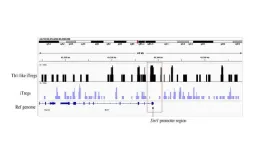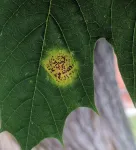(Press-News.org) EMBARGOED FOR RELEASE UNTIL 4 P.M. ET, TUESDAY, FEBRUARY 27, 2024
MINNEAPOLIS – Pesticides and herbicides used in farming have been linked to Parkinson’s disease in the Rocky Mountain and Great Plains region of the country, according to a preliminary study released today, February 27, 2024, that will be presented at the American Academy of Neurology’s 76th Annual Meeting taking place April 13–18, 2024, in person in Denver and online.
“We used geographic methods to examine the rates of Parkinson’s disease across the United States and compared those rates to regional levels of pesticide and herbicide use,” said study author Brittany Krzyzanowski, PhD, of Barrow Neurological Institute in Phoenix, Arizona. “Our methods enabled us to identify parts of the nation where there was a relationship between most pesticides and Parkinson’s disease and subsequently pinpoint where the relationship was strongest so we could explore specific pesticides in that region. In the Rocky Mountain and Great Plains region, we identified 14 pesticides associated with Parkinson’s disease.”
Krzyzanowski said the region included parts of Colorado, Idaho, Kansas, Montana, Nebraska, Nevada, New Mexico, North Dakota, Oklahoma, South Dakota, Texas, Utah and Wyoming.
The study involved review of records from the 21.5 million people enrolled in Medicare in 2009 to determine the rate of Parkinson’s disease for various regions across the country. The researchers then looked for a possible relationship between these rates of Parkinson’s and the use of 65 pesticides.
They found that the pesticides and herbicides simazine, atrazine and lindane had the strongest relationship with Parkinson’s disease. When researchers divided counties into 10 groups based on exposure to pesticides, people living in the counties with the highest amount of application of the herbicide simazine were 36% more likely to have Parkinson’s disease than people living in the counties with the lowest amount of exposure.
In the counties with the highest exposure to simazine, 411 new Parkinson’s disease cases developed per every 100,000 people compared to 380 cases in the counties with the lowest exposure.
For the herbicide atrazine, those exposed to the highest amount were 31% more likely to have Parkinson’s disease than those with the lowest exposure. For the insecticide lindane, those with the most exposure were 25% more likely to have the disease.
In the counties with the highest exposure to atrazine, 475 new Parkinson’s disease cases developed per every 100,000 people compared to 398 cases in the counties with the lowest exposure. In the counties with the highest exposure to lindane, 386 new Parkinson’s disease cases developed per every 100,000 people compared to 349 cases in the counties with the lowest exposure.
The results remained the same when researchers adjusted for other factors that could affect the risk of Parkinson’s disease, such as air pollution exposure.
“It’s concerning that previous studies have identified other pesticides and herbicides as potential risk factors for Parkinson’s, and there are hundreds of pesticides that have not yet been studied for any relationship to the disease,” Krzyzanowski said. “Much more research is needed to determine these relationships and hopefully to inspire others to take steps to lower the risk of disease by reducing the levels of these pesticides.”
A limitation of the study was that it relied on the use of county-level estimates since person-level information on pesticide exposure was not available for the study population.
The study was supported by the Michael J. Fox Foundation for Parkinson’s Research.
Learn more about Parkinson’s disease at BrainandLife.org, home of the American Academy of Neurology’s free patient and caregiver magazine focused on the intersection of neurologic disease and brain health. Follow Brain & Life® on Facebook, X and Instagram.
When posting to social media channels about this research, we encourage you to use the American Academy of Neurology’s Annual Meeting hashtag #AANAM.
The American Academy of Neurology is the world’s largest association of neurologists and neuroscience professionals, with over 40,000 members. The AAN is dedicated to promoting the highest quality patient-centered neurologic care. A neurologist is a doctor with specialized training in diagnosing, treating and managing disorders of the brain and nervous system such as Alzheimer’s disease, stroke, migraine, multiple sclerosis, concussion, Parkinson’s disease and epilepsy.
For more information about the American Academy of Neurology, visit AAN.com or find us on Facebook, X, Instagram, LinkedIn and YouTube.
END
Study finds pesticide use linked to Parkinson’s in rocky mountain, great plains region
2024-02-27
ELSE PRESS RELEASES FROM THIS DATE:
Researchers make precious headway into a genetic form of Alzheimer’s disease
2024-02-27
(Santa Barbara, Calif.) — UC Santa Barbara researchers and collaborators in Colombia, Brazil and Germany are progressing toward an understanding of mechanisms that underlie Alzheimer’s disease, in particular an early-onset, genetic form that has afflicted generations of an extended family in Colombia. They also shed some light on a woman from that family who managed to beat the odds.
“What are the chances,” said UCSB neuroscientist Kenneth S. Kosik, a senior author of a paper that appears in the journal Neuron. “It’s unbelievable serendipity.”
It all takes place in the ...
CBD shown to ease anxiety without the risks that can come with THC
2024-02-27
Cannabis products high in the nonintoxicating compound CBD can quell anxiety better than THC-dominant products— and without the potential side effects, new University of Colorado Boulder research suggests.
The study of 300 people, published in the journal Cannabis and Cannabinoid Research, is the first randomized trial to examine how legal, commercially available cannabis impacts anxiety symptoms.
The study comes as one in five U.S. adults suffer from an anxiety disorder, making it the most common mental illness in the country, and prescriptions for anti-anxiety medications are on the rise.
“We ...
Sniffing our way to better health
2024-02-27
RIVERSIDE, Calif. -- Imagine if we could inhale scents that delay the onset of cancer, inflammation, or neurodegenerative disease. Researchers at the University of California, Riverside, are poised to bring this futuristic technology closer to reality.
In lab experiments, a team led by Anandasankar Ray, a professor of molecular, cell and systems biology, exposed the fruit fly (Drosophila melanogaster) to diacetyl, a microbial volatile compound released by yeast, and found changes in gene expression in the fly’s antennae in just a few days. In separate experiments, ...
Texas Tech and TTUHSC professors honored as NAI senior members
2024-02-27
The National Academy of Inventors (NAI) has announced four faculty members from the Texas Tech University System as part of the 2024 class of Senior Members.
Noureddine Abidi and Seshadri Ramkumar, both professors at Texas Tech University; Annelise Nguyen, associate dean for research at the School of Veterinary Medicine in Amarillo; and Hongjun (Henry) Liang, a professor from Texas Tech University Health Sciences Center (TTUHSC), join 120 other emerging academic inventors in this year’s class.
“These individuals are great representatives of the innovative spirit here at Texas Tech and are highly deserving of this recognition,” ...
UMass Amherst researchers identify enzyme key to training cells to fight autoimmune disorders
2024-02-27
Februay 27, 2024
UMass Amherst Researchers ID Enzyme Key to Training Cells to Fight Autoimmune Disorders
Discovery of new signaling pathway in immune cells may lay the foundation for drug-free, side-effect-free treatments for patients with aplastic anemia and other autoimmune disorders
AMHERST, Mass. – Researchers at the University of Massachusetts Amherst recently released a first-of-its-kind study that focuses on the rare autoimmune disorder aplastic anemia to understand how a subset of cells might be trained to correct the overzealous immune response that can lead to fatal autoimmune disorders. The research, published in Frontiers in Immunology, ...
Addressing societal concerns of genetic determinism of human behavior by linking environmental influences and genetic research
2024-02-27
It has long been known that there is a complex interplay between genetic factors and environmental influences in shaping behavior. Recently it has been found that genes governing behavior in the brain operate within flexible and contextually responsive regulatory networks. However, conventional genome-wide association studies (GWAS) often overlook this complexity, particularly in humans where controlling environmental variables poses challenges.
In a new perspective article publishing February 27th in the open-access journal PLOS Biology ...
Biodiversity appears to strongly suppress pathogens and pests in many plant and animal systems, but this “dilution effect” can vary strikingly in magnitude
2024-02-27
Biodiversity appears to strongly suppress pathogens and pests in many plant and animal systems, but this “dilution effect” can vary strikingly in magnitude
This study uses forest inventory data from over 25,000 plots to show that the prevalence of tree pests is jointly controlled by the diversity and phylogenetic composition of forests
#####
In your coverage, please use this URL to provide access to the freely available paper in PLOS Biology: http://journals.plos.org/plosbiology/article?id=10.1371/journal.pbio.3002473
Press-only preview: PENDING
Contact: Andrew Gougherty, andrew.gougherty@usda.gov
Image ...
Study shows bariatric surgery provides superior long-term treatment for type 2 diabetes in patients with obesity
2024-02-27
Tuesday, February 27, 2024, CLEVELAND: Research by Cleveland Clinic and three other U.S. medical centers has found that bariatric surgery provides better long-term control of blood glucose levels in patients with obesity and type 2 diabetes, compared with medical therapy.
Study participants who had bariatric surgery also experienced higher rates of complete diabetes remission up to 12 years after their surgical procedure.
The research was published in JAMA.
The Alliance of Randomized trials of Medicine vs Metabolic Surgery in Type 2 Diabetes (ARMMS-T2D) consortium analyzed long-term results of four randomized trials that were ...
Diet linked to preeclampsia among low-income Hispanic women during pregnancy
2024-02-27
A research study led by the Keck School of Medicine of USC found that certain combinations of foods consumed during pregnancy may be linked to a higher likelihood of developing preeclampsia, a potentially life-threatening blood pressure condition that can have serious consequences for both mother and baby.
The study, which focuses on low-income Hispanic women in Los Angeles, suggests that different combinations of foods in a woman's diet during pregnancy have the potential to increase or reduce the likelihood of preeclampsia development, and that interventions in diet during pregnancy may help reduce the risk of preeclampsia.
It is known that Hispanic women develop ...
Exposure to secondhand smoke during chemotherapy makes treatment less effective, study shows
2024-02-27
People who are diagnosed with head and neck cancer often receive a standard type of chemotherapy as part of their treatment. If they are exposed to secondhand smoke during chemotherapy — even if they have never smoked themselves — the treatment may be far less effective at killing cancer cells. That finding, considered the first of its kind, was revealed in a study recently published by researchers at the University of Oklahoma Health Sciences.
Tobacco use is a well-established risk factor for cancer and a signal of poor outcomes, especially ...






